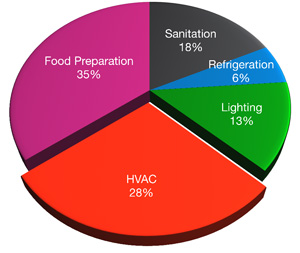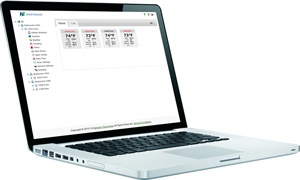Remote sensors: a path to profit for your restaurant.
By Jerry Drew and Joe Neubauer
Heating and cooling costs are the largest controllable energy expense of your restaurant. According to the EPA, restaurant HVAC systems use the most amount of energy after food preparation.1 In fact, your HVAC system is one of the greatest opportunities to add profit back to your bottom line. In addition, the ability to monitor and warn you of food storage failures can save profits and protect your bottom line. Let’s look at how we can integrate remote sensors into your restaurant.
Start With The Right Platform
 Commercial Internet of Things (IoT) technology advancements are allowing restaurateurs to monitor and manage all of their locations without the burdensome expense of traditional Building Automation System (BAS) solutions. Doing a lot more than turning on and off your HVAC equipment, the power of commercial-grade ecosystems centers around the flexibility of connected thermostats. These affordable solutions have the ability to collect data for evaluating energy consumption, provide guidance for enhanced energy savings, and even monitor and alert for non-HVAC related areas of interest. Don’t confuse residential “smart” thermostats with commercial-grade solutions. Commercial-grade solutions offer optimized schedules for business use, tools for managing multiple thermostats together, and remote management software options with the security your restaurant requires. Adding the power of remote sensors is just one part of the commercial grade ecosystem to further reduce energy consumption and protect your food inventory.
Commercial Internet of Things (IoT) technology advancements are allowing restaurateurs to monitor and manage all of their locations without the burdensome expense of traditional Building Automation System (BAS) solutions. Doing a lot more than turning on and off your HVAC equipment, the power of commercial-grade ecosystems centers around the flexibility of connected thermostats. These affordable solutions have the ability to collect data for evaluating energy consumption, provide guidance for enhanced energy savings, and even monitor and alert for non-HVAC related areas of interest. Don’t confuse residential “smart” thermostats with commercial-grade solutions. Commercial-grade solutions offer optimized schedules for business use, tools for managing multiple thermostats together, and remote management software options with the security your restaurant requires. Adding the power of remote sensors is just one part of the commercial grade ecosystem to further reduce energy consumption and protect your food inventory.
Remote Room Sensors & Room Temperature Averaging
Often thermostats are not positioned to adequately monitor the space temperature they are controlling. Whether the thermostat is located near the kitchen or locked in a manager’s office, remote room temperature sensors can monitor the immediate space temperature and operate the HVAC based on their data. Some solutions allow for remote sensors to be used individually or averaged together to provide a more uniform climate in large or multi-room applications.
Outside, Supply and Return Air Sensors
Commercial IoT systems can measure outside temperature, supply air and return air from HVAC equipment, allowing HVAC equipment efficiencies to be monitored. The systems can intelligently alert you when it detects conditions that require inspection and/or service.
 Prevent Food Loss / Optimize Food Safety
Prevent Food Loss / Optimize Food Safety
Everyone knows that a freezer malfunction or even a food case malfunction can result in a complete inventory loss. Remote sensors are the solution to this potential nightmare. There are remote temperature and humidity sensors that can monitor and alert you about your freezer, refrigerator, cooler and display case food storage conditions. Make sure to choose sensors that are designed for the appropriate temperature range for each application. Alerts can be customized for your specific needs. A notification that saves precious product should one of these assets fail could easily pay for the entire solution with a single equipment failure instance.
Microbreweries use liquid-based temperature sensors to monitor their brewing and cold storage to ensure their product is made and stored safely. Graphing over time from the remote management system ensures precise temperature control is maintained through the entire process.
Other Protection Sensors
Water detection sensors can monitor a drip pan in the ceiling to provide advanced notification of a condensation issue saving you the expense of water damage repair. Carbon dioxide detectors can automatically open fresh air vents and turn on fans if an issue arises. Contact sensors can be installed for walk-in freezers or display cases to ensure they are closed properly. The possibilities are nearly endless, and commercial IoT ecosystems can integrate all of them.
 Return on Investment
Return on Investment
Optimizing commercial-grade IoT systems requires a holistic approach. Integrating remote sensors is just one part of the solution. A good, reliable, commercial-grade energy management solution allows you to securely control your HVAC system and monitor your food storage and production equipment from a single dashboard interface. In addition, customizable alert systems will notify you if your remote sensors detect out-of-spec temperature alerts or food storage equipment failures. Typically, equipped remote sensor IoT commercial-grade solutions can provide a realistic return-on-investment in a year or less. A single, early detection, food storage equipment failure can pay for that system overnight. With all these benefits, adding remote sensors will deliver peace of mind and profit to your bottom line for years to come.
— Jerry Drew is the CEO of Network Thermostat and Robertshaw Climate. Joe Neubauer is a solutions specialist for Network Thermostat, a leader in 100% standalone, communicating energy management solutions. For more information, visit www.networkthermostat.com.
